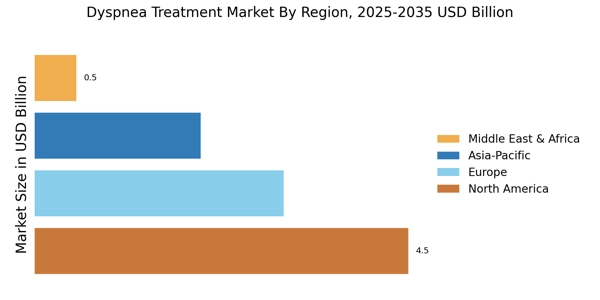Growing Awareness and Education
There is a notable increase in awareness and education regarding respiratory health, which is positively impacting the Dyspnea Treatment Market. Public health campaigns and initiatives aimed at educating individuals about the symptoms and management of dyspnea are fostering a more informed patient population. This heightened awareness encourages individuals to seek medical attention sooner, leading to earlier diagnosis and treatment of underlying conditions. Consequently, healthcare providers are experiencing an uptick in patient consultations related to dyspnea, driving demand for effective treatment options. Additionally, educational programs targeting healthcare professionals are enhancing their ability to recognize and manage dyspnea effectively. This trend is likely to continue, as ongoing efforts to promote respiratory health awareness are expected to further stimulate growth within the Dyspnea Treatment Market.
Advancements in Medical Technology
Technological advancements in medical devices and treatment methodologies are significantly influencing the Dyspnea Treatment Market. Innovations such as portable oxygen concentrators, nebulizers, and advanced inhalers are enhancing patient care and improving treatment outcomes. The integration of telemedicine and digital health solutions is also transforming how patients access care, allowing for remote monitoring and management of dyspnea symptoms. This shift not only improves patient convenience but also expands the reach of healthcare providers. As a result, the Dyspnea Treatment Market is witnessing a surge in demand for these advanced technologies, which are expected to play a crucial role in shaping future treatment paradigms. The ongoing development of smart inhalers and connected devices may further enhance adherence to treatment regimens, ultimately leading to better health outcomes.
Aging Population and Healthcare Demand
The aging population is a significant factor driving the Dyspnea Treatment Market. As individuals age, they become more susceptible to chronic respiratory conditions, leading to an increased demand for effective treatment options. The demographic shift towards an older population is evident in many regions, with projections indicating that the proportion of elderly individuals will continue to rise. This trend is likely to place additional strain on healthcare systems, necessitating the development of targeted therapies for managing dyspnea. The Dyspnea Treatment Market is responding to this challenge by focusing on creating age-appropriate treatment solutions that cater to the unique needs of older patients. Additionally, the growing prevalence of comorbidities among the elderly population further complicates treatment strategies, underscoring the need for comprehensive management approaches.
Rising Prevalence of Respiratory Diseases
The increasing incidence of respiratory diseases, such as chronic obstructive pulmonary disease (COPD) and asthma, is a primary driver of the Dyspnea Treatment Market. According to recent estimates, respiratory diseases affect millions of individuals worldwide, leading to a heightened demand for effective treatment options. This trend is likely to continue as urbanization and pollution levels rise, exacerbating respiratory conditions. The Dyspnea Treatment Market is responding to this growing need by developing innovative therapies and medications aimed at alleviating symptoms. Furthermore, the aging population is particularly susceptible to respiratory ailments, further contributing to market growth. As healthcare systems adapt to these challenges, investments in research and development are expected to increase, fostering advancements in treatment methodologies.
Increased Investment in Research and Development
Investment in research and development is a critical driver of the Dyspnea Treatment Market. Pharmaceutical companies and research institutions are increasingly focusing on developing novel therapies and treatment modalities for dyspnea. This trend is fueled by the recognition of the substantial unmet medical needs in managing respiratory conditions. Recent data indicates that R&D spending in the respiratory sector has seen a significant uptick, with many organizations prioritizing the exploration of new drug candidates and treatment approaches. The Dyspnea Treatment Market stands to benefit from these advancements, as innovative therapies are likely to emerge, offering improved efficacy and safety profiles. Furthermore, collaborations between academia and industry are fostering a conducive environment for breakthrough discoveries, which may reshape the landscape of dyspnea management.


















Leave a Comment